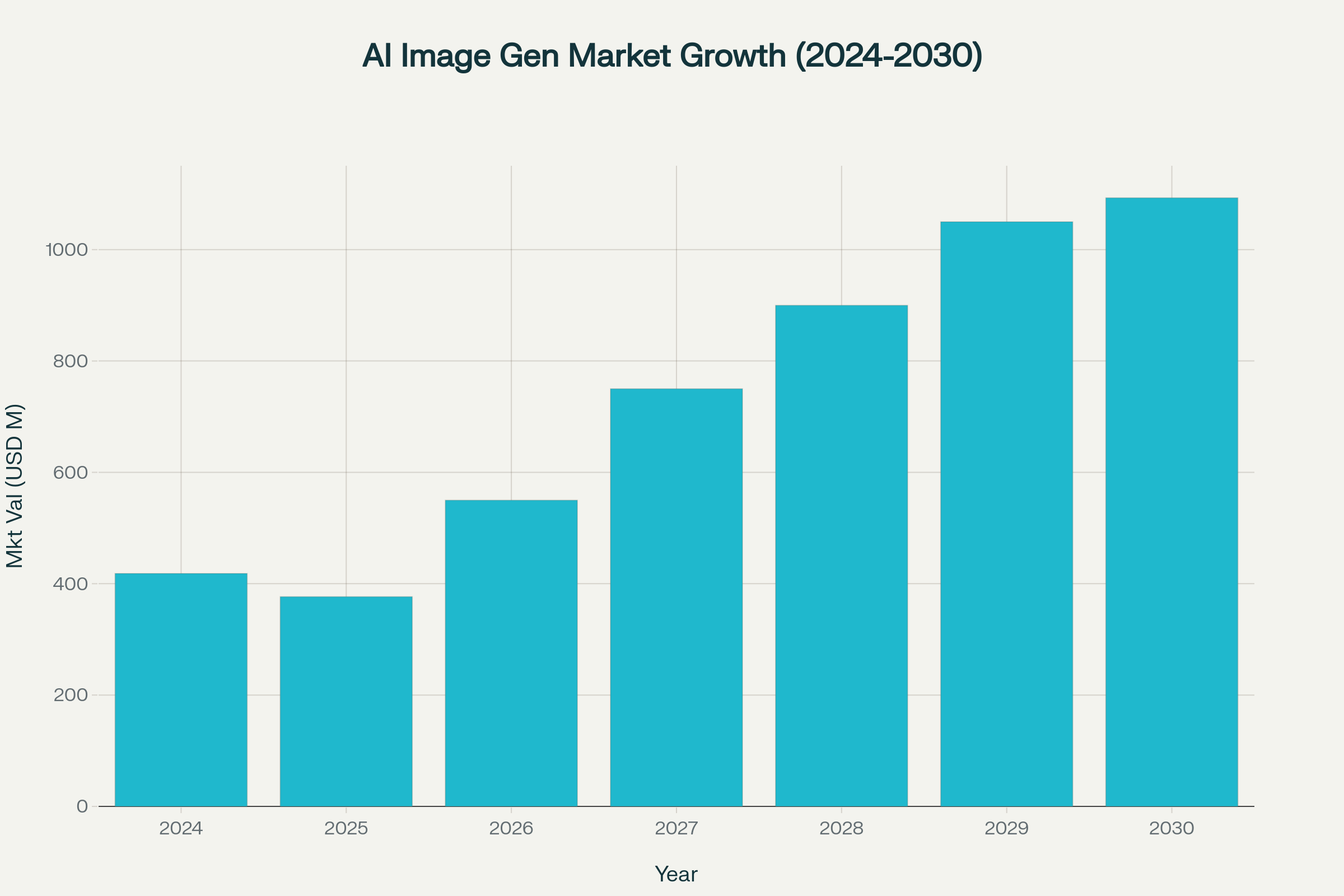Key Highlights:
- Microsoft AI image generator MAI-Image-1 secures 9th position on LMArena leaderboard with 1096 score, marking Microsoft’s first fully in-house developed text-to-image model
- The new image generation tool excels at photorealistic imagery with advanced lighting effects, processing requests faster than larger competing models
- Global market integration expected across Copilot and Bing platforms, targeting $1.09 billion market opportunity by 2030
Microsoft has officially launched MAI-Image-1, its first completely in-house developed Microsoft AI image generator, achieving immediate recognition within the competitive artificial intelligence landscape. The October 13, 2025 announcement represents Microsoft’s strategic pivot toward technological independence from external AI partnerships, particularly with OpenAI. The Microsoft AI image generator secured 9th position among the top 10 text-to-image models on LMArena, the crowdsourced benchmarking platform where human evaluators compare and vote on model outputs. This achievement positions the new tool as a direct competitor to established solutions including OpenAI’s DALL-E series and various proprietary models from Tencent, Bytedance, and other technology companies.
The global AI image generator market presents substantial growth opportunities for Microsoft’s new platform, with market valuations projected to expand from $418.5 million in 2024 to $1,093.1 million by 2030, representing a compound annual growth rate of 16.4 percent. Multiple market research firms project even higher growth trajectories, with some estimates suggesting the market could reach $2.63 billion by 2035 at an 18.2 percent CAGR. North America maintains market dominance with significant revenue share, creating advantageous positioning for Microsoft AI image generator launch within its established customer base.

AI Image Generator Market Growth Projections showing steady expansion from $418.5 million in 2024 to $1,093.1 million by 2030
Technical Performance and Competitive Analysis
The Microsoft AI image generator demonstrates specialized capabilities in photorealistic image creation, particularly excelling in complex lighting scenarios including bounce light effects, reflections, and landscape generation. Microsoft’s development approach prioritized rigorous data selection and nuanced evaluation processes, incorporating extensive feedback from professional creators across multiple industries to avoid repetitive or generically-stylized outputs common in competing alternatives. The model’s architecture enables faster processing compared to larger, slower competing models, allowing users to iterate quickly through creative concepts and seamlessly transfer work to other design applications.
LMArena‘s ranking methodology provides crucial market validation for the tool’s competitive positioning within the industry ecosystem. The platform’s human-driven evaluation system involves side-by-side comparisons where users vote for superior outputs, making the top 10 achievement particularly significant for market credibility and adoption potential. The Microsoft AI image generator scored 1096 points, positioning it ahead of several established models while trailing leaders like Tencent’s Hunyuan model at 1161 points. This performance demonstrates the platform’s technical competency relative to industry standards and provides benchmarking data for future development iterations.

LMArena Top 10 Text-to-Image Models Rankings showing Microsoft AI MAI-Image-1 achieving 9th position with 1096 score
| Model Ranking | Company | Model Name | LMArena Score | Market Position |
|---|---|---|---|---|
| 1st | Tencent | Hunyuan Community | 1161 | Market Leader |
| 2nd | Proprietary | Unnamed Model | 1154 | Top Competitor |
| 3rd | Proprietary | Unnamed Model | 1145 | Top Competitor |
| 7th | OpenAI | DALL-E Series | 1123 | Established Player |
| 9th | Microsoft AI | MAI-Image-1 | 1096 | New Market Entrant |
Strategic Market Positioning and Integration Roadmap
Microsoft‘s launch of the Microsoft AI image generator represents the third addition to its expanding portfolio of purpose-built AI models, following MAI-Voice-1 and MAI-1-preview released in August 2025. This systematic expansion demonstrates Microsoft’s commitment to reducing dependency on external AI partnerships while maintaining collaborative relationships under modified agreements with OpenAI. The new platform will initially undergo public testing on LMArena before full integration into Microsoft’s consumer-facing products including Copilot and Bing Image Creator platforms.
Market analysts project continued enterprise adoption growth for AI image generation tools, with Microsoft’s existing customer ecosystem providing natural distribution channels for the new solution. Several financial analysts estimate Microsoft’s AI-related products, including the image generation platform, could generate $10 billion or more in annual revenue by 2026, representing substantial market opportunity within the broader generative AI sector valued at $37.89 billion in 2025. The Microsoft AI image generator integration timeline focuses on near-term deployment, with official announcements indicating availability in Copilot and Bing Image Creator “very soon” according to Microsoft communications.
Investment Infrastructure and Development Capabilities
Microsoft’s substantial AI infrastructure investments directly support platform development and deployment capabilities, with the company forecasting record $30 billion capital expenditures for fiscal Q1 2025. These investments include next-generation GB200 cluster infrastructure now operational for advanced model training, positioning the development within comprehensive computational resources. The company’s Azure cloud computing business exceeded $75 billion in annual sales for the first time, demonstrating the revenue generation potential for Microsoft AI image generator integration across cloud platforms.
The Microsoft AI development team operates as a “lean, fast-moving lab” comprised of specialized talent focused on ambitious model development objectives, including continued enhancement of the image generation capabilities. Microsoft’s approach emphasizes purpose-built models designed for specific use cases rather than general-purpose solutions, suggesting the platform will undergo continued specialization and optimization for creative professional workflows. Future development roadmaps likely include enhanced creative capabilities, improved processing speeds, and expanded integration across Microsoft’s comprehensive product ecosystem.
| Investment Category | 2025 Allocation | Strategic Focus | Platform Impact |
|---|---|---|---|
| Capital Expenditures | $30 billion Q1 | Infrastructure Development | Enhanced Processing Capabilities |
| Azure Revenue | $75+ billion annual | Cloud Platform Growth | Distribution Channel Expansion |
| AI Research & Development | Undisclosed | Model Innovation | Technology Advancement |
| Market Opportunity | $1.09 billion by 2030 | Image Generation Sector | Revenue Potential |
Closing Assessment
Microsoft’s introduction of the MAI-Image-1 represents a pivotal strategic milestone in the company’s journey toward AI independence and creative technology market leadership. The Microsoft AI image generator immediate success in achieving top 10 LMArena rankings demonstrates technical competency rivaling established competitors while addressing specific pain points identified by creative professionals seeking alternatives to generic outputs. The platform’s emphasis on photorealistic quality, processing efficiency, and practical creative applications positions it advantageously within the rapidly expanding market projected to exceed $1.09 billion by 2030 with potential growth to $2.63 billion by 2035.
As Microsoft continues integrating the Microsoft AI image generator into consumer and enterprise products throughout 2025, its impact on creative workflows and competitive dynamics within the AI image generation sector will likely accelerate, supported by substantial infrastructure investments and established distribution channels across the Microsoft ecosystem.


